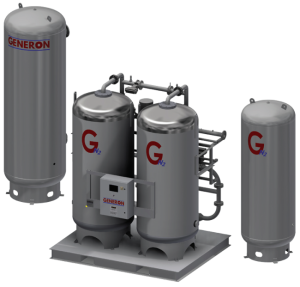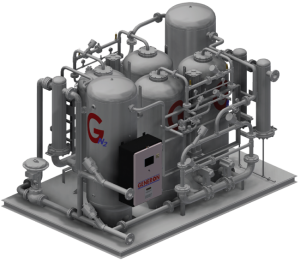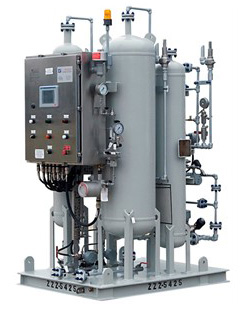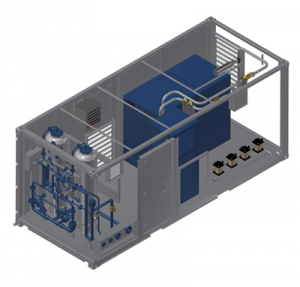 Family of Nitrogen Generators
Family of Nitrogen Generators

PSA Nitrogen Generator
The GENERON Group is one of the world’s largest manufacturer of PSA Nitrogen Generators and has over 40 years of experience in the design and manufacture of Nitrogen Pressure Swing Adsorption (PSA) systems. With many standard models to choose from, GENERON has a model that is right for you. If one of our 50+ standard models does not meet your needs, we can custom build one to your exact specifications.
GENERON has over 2,000 systems installed worldwide in most markets, including Manufacturing, Marine, Petrochemical, and Oil & Gas. The GENERON Group has three manufacturing facilities supporting its PSA and Membrane fabrication needs. All Process and Nitrogen Membranes are manufactured at its California Facility and system fabrication is accomplished in its Texas or China facilities.
Why Choose GENERON Group for your PSA Nitrogen Generator Requirements:
RELIABILITY / EXPERIENCE
- The key to making the investment in Nitrogen Generation equipment is to be certain you are purchasing from a dependable company. GENERON has thousands of systems installed and operating worldwide.
- GENERON has one of the largest product portfolios on the market with over 50 standard models to choose from, and purities up to 99.9995% and flow rates to 2,030 scfm (3,200 Nm3/h)
- Quality is assured and maintained through ISO-9001 certified design and manufacturing facilities.
COST SAVINGS
- Cost saving of 50% to 300% when compared to bulk liquid supply, dewar, and Nitrogen cylinders
- Continuous supply, will never run out of Nitrogen
- No complicated supply contracts with ever escalating charges
SAFETY
- No safety or handling issues associated with bulky high pressure cylinders
- Eliminates the dangers of cryogenic liquids
PSA NITROGEN GENERATION SYSTEMS:
 MODULAR BANK PSA
MODULAR BANK PSA
- N₂ Capacity: 124 – 7428 SCFH @ 90 – 150psig
- Foot Print: 65” L x 24” W x 72” H
 TWIN TOWER PSA
TWIN TOWER PSA
- N₂ Capacity: 800 – 112,000 SCFH @ 100 – 145 psig
- Foot Print: 58” – 156” L x 52” – 120” W x 58” – 156” H
 SEQUENTIAL PSA
SEQUENTIAL PSA
- N₂ Capacity: up to 254,000 SCFH @ 100 – 145 psig
- Foot Print: 116”-240”” L x 96” W x 108” H
 CONTAINERIZED SYSTEM
CONTAINERIZED SYSTEM
with feed compressions & pre-treatment
- N₂ Capacity: 600 – 25,000 SCFH @ 100 – 145 psig
- Foot Print: 240” – 480” L x 96” W x 114” H
 MARINE SEQUENTIAL PSA
MARINE SEQUENTIAL PSA
- N₂ Capacity: up to 254,000 SCFH @ 100 – 145 psig
- Foot Print: 116”-240”” L x 96” W x 108” H
What Is a Pressure Swing Adsorption (PSA) Nitrogen Generator?
PSA is a technology used to separate some gas species from a mixture of gases under pressure according to the species’ molecular characteristics and affinity for an adsorbent material. It operates at near-ambient temperatures and differs significantly from cryogenic distillation techniques of gas separation. Specific adsorptive materials (e.g., activated carbon, molecular sieves, etc.) are used as a trap, preferentially adsorbing the target gas species at high pressure. The process then swings to low pressure to desorb the adsorbed material.
How Does an Industrial PSA Nitrogen Generator Work?
Pressure swing adsorption processes rely on the fact that under high pressure, gases tend to be attracted to solid surfaces, or “adsorbed”. The higher the pressure, the more gas is adsorbed; when the pressure is reduced, the adsorbed gas is released, or desorbed. PSA processes can be used to separate gases from a mixture because different gases tend to be attracted to different solid surfaces more or less strongly. If a gas mixture such as air, for example, is passed under pressure through a vessel containing an adsorbent bed of Carbon Molecular Sieve (CMS) that attracts oxygen more strongly than it does nitrogen, part or all of the oxygen will stay in the bed, and the gas coming out of the vessel will be enriched in nitrogen. When the bed reaches the end of its capacity to adsorb oxygen, it can be regenerated by reducing the pressure, thereby releasing the adsorbed oxygen. It is then ready for another cycle of producing high purity nitrogen gas.
Using two adsorbent vessels allows near-continuous production of the target gas. It also permits so-called pressure equalization, where the gas leaving the vessel being depressurized is used to partially pressurize the second vessel. This results in significant energy savings, and is common industrial practice.
Typical System Configuration (PFD)
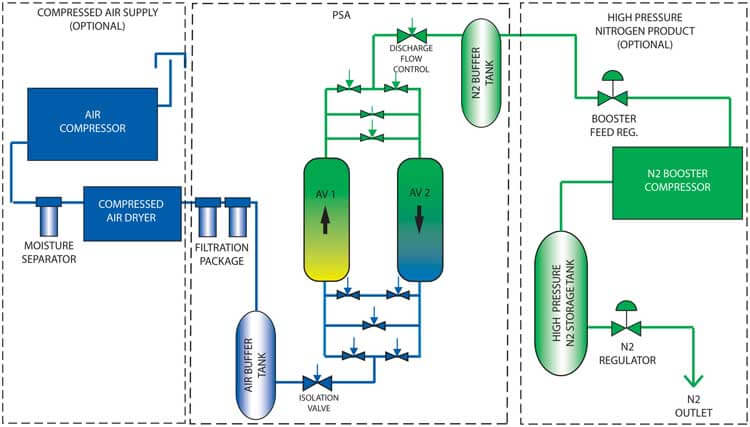
System Specification
- GENERON can offer complete turn-key system design, including all system components and design drawings. Our technical teams work directly with our clients to specify and install systems to our customer’s exact specifications. GENERON has a full service team ready 24 / 7 to answer any question you may have.
Technology
How a Pressure Swing adsorption (PSA) system works:
GENERON® Nitrogen PSA Generator Systems use the basic principle of passing air over a bed of engineered adsorbent material, which bonds with oxygen, leaving a rich stream of nitrogen gas to exit.
The adsorption separation is accomplished by the following process steps:
- FEED AIR COMPRESSION AND CONDITIONING
The inlet (ambient) air is compressed by an air compressor, dried by an air dryer, and filtered, before entering the process vessels.
- PRESSURIZATION AND ADSORPTION
The pre-treated and filtered air is directed into a vessel filled with Carbon Molecular Sieve (CMS) where the oxygen is adsorbed preferentially in the CMS pores. This allows concentrated nitrogen, with an adjustable purity, (as low as 50 ppm O2) to remain in the gas stream and flow out of the vessel. Before the full adsorption capacity of the CMS is reached, the separation process interrupts the inlet flow, and switches to the other adsorber vessel.
- DESORPTION
The oxygen-saturated CMS is regenerated (the adsorbed gases are released) by means of a pressure reduction, below that of the previous adsorption step. This is achieved by a simple pressure release system where the exhaust (waste) gas stream is vented from the vessel, usually through a diffuser or silencer and back into safe surrounding atmosphere. The regenerated CMS is refreshed and can now be used again for the generation of nitrogen.
- ALTERNATING VESSELS or SWING
Adsorption and desorption should take place alternately at equal time intervals. This means that the continuous generation of nitrogen can be achieved by using two adsorbers; while one is adsorbing, the other is in regeneration mode; and switching back and forth, provides for a continuous and controlled flow of nitrogen.
- NITROGEN RECEIVER
Constant nitrogen product flow and purity is ensured by a connected product buffer vessel that stores the nitrogen output. This can be designed for nitrogen purities up to 99.9995% and pressures up to 150 psig (10 bar).
- NITROGEN PRODUCT
The result product is a constant stream of On Site produced, high purity Nitrogen, at a cost significantly below the price of liquid or bottled gases.
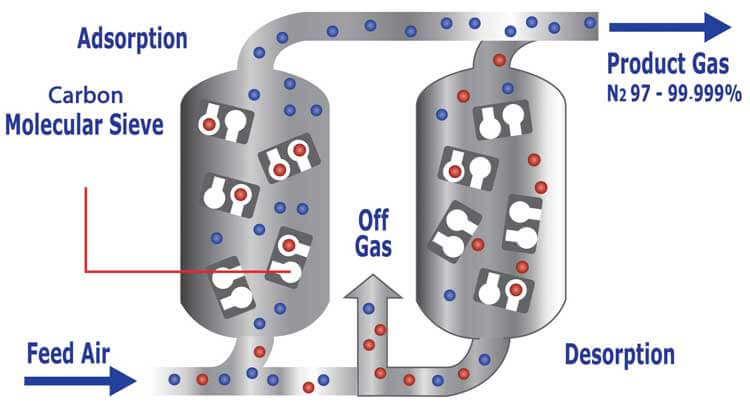

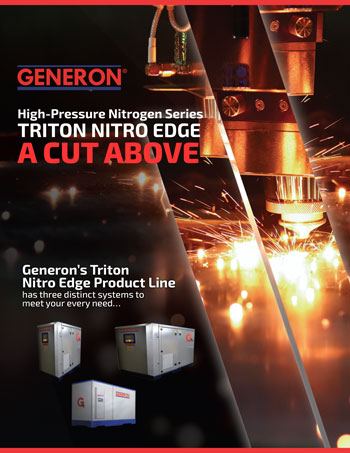
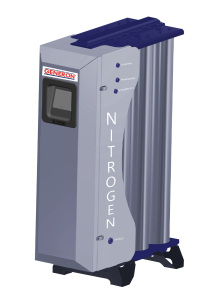 MODULAR BANK PSA
MODULAR BANK PSA